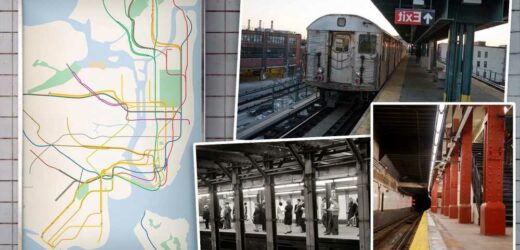More On:
subways
Another sign Andrew Cuomo cares more about winning headlines than results
NYPD searching for man accused of pummeling woman inside subway station
Letters to the Editor — July 10, 2021
Commuters wade through underground lakes as rain turns NYC into Atlantis
The unfathomably complex labyrinth of the New York City Subway is largely a mystery to riders beyond the few stations and routes they use every day.
But its sprawling tentacles — subterranean, open-air and elevated — are as clear as a sunlit pond to Peter Dougherty, 60, an amateur railroad enthusiast who’s been something of a mystery himself.
So self-effacing that he’s never previously been photographed in the media, he might know more about the system than anyone outside the MTA — perhaps more than anyone inside it.
The 2021 edition of his challenging but awe-inspiring book, “Tracks of the New York City Subway,” maps its 691 track miles, 472 stations (the most of any system in the world) and 2,000 track switches in microscopic detail. If you thought signals were as simple as red, yellow and green, wait until you see Page 113.
“Tracks” should enthrall the growing number of riders who are returning to the subways — 2.5 million in a single day last month, far below pre-pandemic totals of 5.5 million but inching up every week from the 385,000 total in April 2020 and expected to soar after Labor Day.
The book isn’t authorized by the MTA, although, “They sold it in their stores until 9/11,” Dougherty said. The MTA feared it could somehow aid terrorists. He says he was careful not to include anything “that could cause harm. For example, I never give precise location of emergency exits or power installations.”
Be warned: “Tracks” is not a beach read. Yard and route-connection maps that resemble microchip patterns, and technical jargon about CBTC signals are not for casual readers who might hope to learn which movies were shot at which stations (although they’re mentioned here and there).
“My target audience is people who are fascinated by the subway system’s inner workings,” Dougherty said. “The same person stands on a platform every day and notices there are signals at the end. They see that the train always goes to the left, not to the right. I was fascinated by this, too.”
The 160 spiral-bound pages left me with a sense of wonder for the subway’s myriad expansions and contractions over more than a century, many of them forgotten in the mist of time. I came away feeling that the system might be the Big Apple’s greatest landmark, even if it isn’t as scenic as Central Park or the Brooklyn Bridge.
Dougherty, who now lives in northern New Jersey, met us inside the Herald Square station. He pointed out a score of obscure vital safety features. Those little yellow thingies on tracks are “trip arms.” They pop up to activate air brakes on the rare occasion that a train crosses a red signal.
“The trip arm enforces a red signal,” he explained. “The arm would raise up at an angle. There’s a white valve at the front of the train. When the yellow paint comes in touch with the white, it leaves a telltale mark, which would tell the inspector that somebody went through a red light.”
Dougherty said the book’s exquisitely intricate maps and graphics are “based on what anyone can see looking out the window of a train, by observation on a platform, from street level, or using online mapping resources” as well as public maps and transit-related Web sites.
But it’s gotten harder over the years. “When I started years ago, I could look out front windows of trains to verify things” — but very few trains today still have single-pane front windows. Dougherty first “got into rail-fanning as a young man in Montreal. I was absolutely amazed you could run a train under the ground.
“My dad said, ‘You like the Montreal Métro? I’m going to New York on business. You can come.’ ”
In 1975, Dougherty was here doing a high school project on urban transportation. A breakthrough moment came when he asked the New York City Transit Authority for a map of the system. “I got this envelope with a treasure trove of maps,” he recalled gleefully. Among them was a 4-by-12-foot system map from 1940 but updated to November 1967.
Still, he didn’t actually get on a train — what was then called the CC at Eighth Avenue and West 50th Street — until a year later, when graffiti and crime reflected the system’s decay. “The condition of the system in the ’70s was more intriguing to me than disturbing, since the Montreal Métro system was new and spotlessly clean,” he said.
He began working on his first book in 1995 and self-published it in 1997. He’s updated it every year since then, incorporating an ever-swelling font of knowledge gleaned from the MTA’s own manuals and postings, discoveries by an army of bloggers, Google Earth and his own acute powers of observation.
He sells only a few hundred copies each year. But his followers always want more. “I’ve been working on next year’s book since February,” he said.
Print edition, $54.95; digital PDF, $29.95 at NYCTrackBook.com/current-edition
Track facts: Gems and details about the railway’s inner workings
Trains ran on the Brooklyn Bridge until March 5, 1944.
In addition to the famous, long-closed City Hall station on the No. 6 line, the system has at least 30 abandoned stations and platforms. I wondered if I only imagined a lower-level platform for the F express at Bergen Street in Brooklyn in the 1970s – until I found it on Page xxxviii.
Look closely at the far side of the No. 6 downtown track at the Union Square station. You’ll see the edge of a platform that was once used for an additional track until both were walled off, possibly as early as 1910.
The yellow garbage trains you see late at night will dump the refuse at 207th Street, 239th Street and Corona Yard.
Blue lights along the track mark the locations of devices that can briefly turn off traction current from the third rail during emergencies. But the power returns after a very short time.
Ever wonder about those colored panels that flash by through the windows of the Manhattan-bound Q and N lines when the train leaves DeKalb Avenue? They’re an exhibit known as Masstransiscope, a 228-panel, hand-painted installation viewed through slits in the wall of a long-abandoned Myrtle Avenue platform.
Those vintage “nostalgia” trains that run during the holiday season are maintained and stored for most of the year in the Coney Island Yard, one of the largest rail yards on the continent. More than 1,000 cars a week pass through the car washer on Track A16.
As amazing as Brooklyn’s Broadway Junction station complex looks today — an Erector Set-like jumble of tracks in the sky — it’s “but a shadow of its former glory,” writes Dougherty. It once included a Fulton Line track, demolished in 1956, in addition to the still-standing J, Z and L lines and the underground A and C. The elevated structure, the system’s oldest, was built in 1885.
Share this article:
Source: Read Full Article











